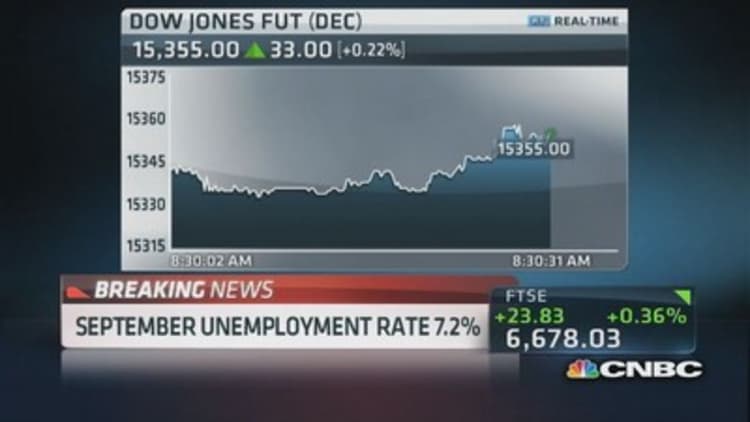September saw the U.S. economy add just 148,000 jobs, significantly worse than expected, according to a report delayed more than two weeks by the government shutdown.
The unemployment rate unexpectedly fell to 7.2 percent, the lowest since November 2008, as the labor-force participation rate held near 35-year lows, according to the Bureau of Labor Statistics.
Private payroll creation stood at just 122,000, with state and local governments adding 28,000 positions and the federal government cutting by 6,000.
(Read more: More young peopleare out of school...and out of work)
Economists had been expecting 180,000 new positions and a steady jobless rate.
"This kind of report adds to the sense of foreboding about our economy," said Claire McKenna, policy analyst at the National Employment Law Project.
Financial markets greeted the report with enthusiasm though, boosting stock futures on expectations that monetary stimulus will remain in place.

A broader measure of unemployment that takes into account the underemployed and those who have quit looking for work also edged lower, to 13.6 percent.
"Today's blistering jobs report has quickly reminded America that our economic problems are getting worse, despite talking point reassurances from Federal Reserve officials," said Todd Schoenberger, managing partner at LandColt Capital.
The report likely will do little to move the needle on monetary policy.
Most market-watchers now expect the Federal Reserve to continue its $85 billion a month bond-buying program until well into 2014. Consensus sentiment is now that the central bank won't even start easing back on, or "tapering," the purchases until the spring.
"You would think by now you would be consistently creating over a couple hundred-thousand jobs a month, at least," said Brian Levitt, senior economist for Oppenheimer Funds. "The Fed wants to see over 200,000 jobs a month on a consistent basis before a change of policy."
(Read more: Thanks, Congress: Data delay means no Fed taper)
The September report provided another reminder that while the jobs market continues to heal it is far from robust.
The bulk of the jobs came from professional and business services, which added 32,000 positions, while there were 20,000 more temporary jobs. Transportation and warehousing rose by 23,000, and there were 20,000 additional construction positions.
One of the strongest areas of job creation over the past several years, leisure and hospitality, lost 7,000 jobs for the month.
Statistical adjustments played little role in the September data, with an approximation the government uses to estimate the number of jobs gained our lost through new and closed businesses—the so-called birth-death model—subtracting 26,000 from the total.
There were, however, significant moves in previous months' counts.
July's growth was revised lower to a paltry 89,000 from 104,000, while August's count was amped up from 169,000 to 193,000.
Wages grew little in the month, with average hourly earnings up just three cents to $24.09, while the average workweek was unchanged at 34.5 hours.
In short, the demand isn't there and the money to pay additional workers isn't there," Kathy Bostjancic, director of macroeconomic analysis for the Conference Board, said in a statement. "Both job and income growth remain stuck in neutral."
(For the full jobs report, click here.)
—By CNBC's Jeff Cox. Follow him on Twitter @JeffCoxCNBCcom.


